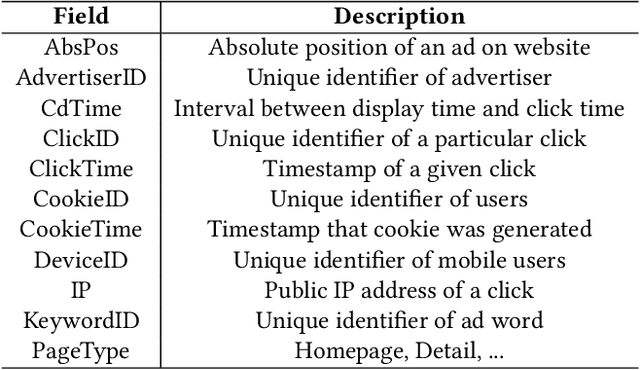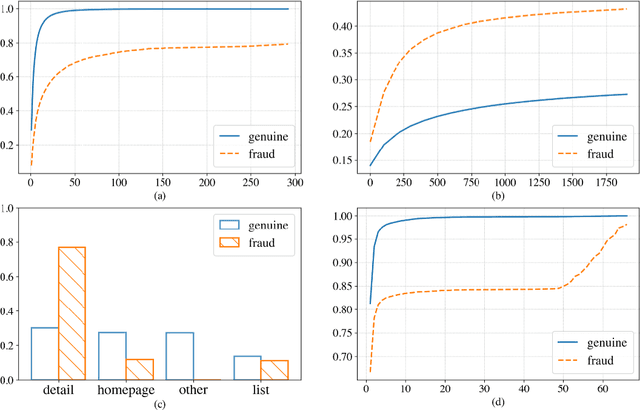Hongchun Zhang
Multimodal and Contrastive Learning for Click Fraud Detection
May 08, 2021



Abstract:Advertising click fraud detection plays one of the vital roles in current E-commerce websites as advertising is an essential component of its business model. It aims at, given a set of corresponding features, e.g., demographic information of users and statistical features of clicks, predicting whether a click is fraudulent or not in the community. Recent efforts attempted to incorporate attributed behavior sequence and heterogeneous network for extracting complex features of users and achieved significant effects on click fraud detection. In this paper, we propose a Multimodal and Contrastive learning network for Click Fraud detection (MCCF). Specifically, motivated by the observations on differences of demographic information, behavior sequences and media relationship between fraudsters and genuine users on E-commerce platform, MCCF jointly utilizes wide and deep features, behavior sequence and heterogeneous network to distill click representations. Moreover, these three modules are integrated by contrastive learning and collaboratively contribute to the final predictions. With the real-world datasets containing 2.54 million clicks on Alibaba platform, we investigate the effectiveness of MCCF. The experimental results show that the proposed approach is able to improve AUC by 7.2% and F1-score by 15.6%, compared with the state-of-the-art methods.
Important Attribute Identification in Knowledge Graph
Oct 12, 2018


Abstract:The knowledge graph(KG) composed of entities with their descriptions and attributes, and relationship between entities, is finding more and more application scenarios in various natural language processing tasks. In a typical knowledge graph like Wikidata, entities usually have a large number of attributes, but it is difficult to know which ones are important. The importance of attributes can be a valuable piece of information in various applications spanning from information retrieval to natural language generation. In this paper, we propose a general method of using external user generated text data to evaluate the relative importance of an entity's attributes. To be more specific, we use the word/sub-word embedding techniques to match the external textual data back to entities' attribute name and values and rank the attributes by their matching cohesiveness. To our best knowledge, this is the first work of applying vector based semantic matching to important attribute identification, and our method outperforms the previous traditional methods. We also apply the outcome of the detected important attributes to a language generation task; compared with previous generated text, the new method generates much more customized and informative messages.
 Add to Chrome
Add to Chrome Add to Firefox
Add to Firefox Add to Edge
Add to Edge